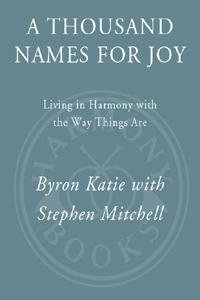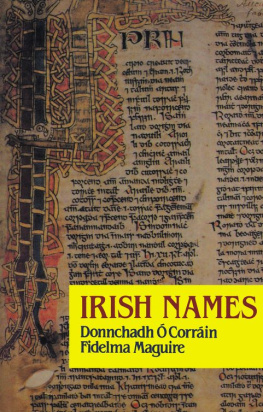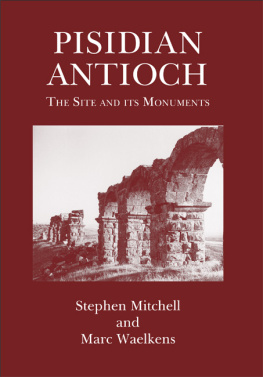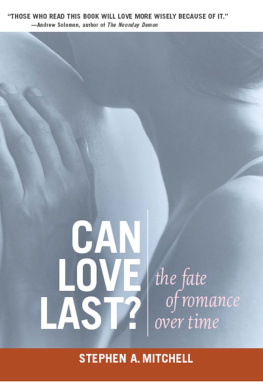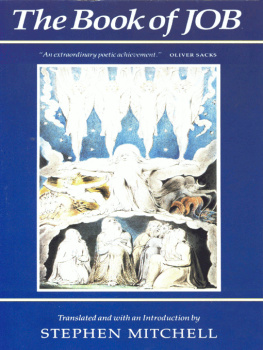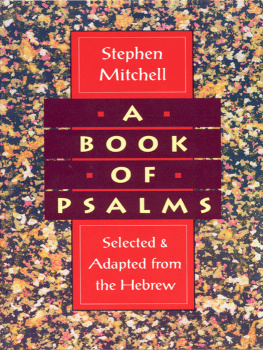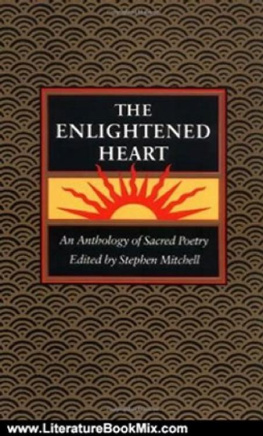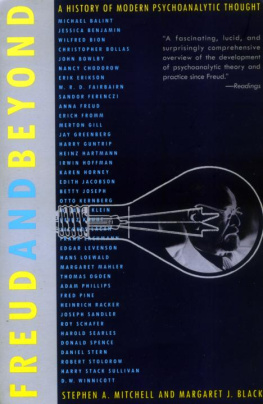Mitchell Stephen - A Thousand Names for Joy: Living in Harmony with the Way Things Are
Here you can read online Mitchell Stephen - A Thousand Names for Joy: Living in Harmony with the Way Things Are full text of the book (entire story) in english for free. Download pdf and epub, get meaning, cover and reviews about this ebook. year: 2007, publisher: Random House, Inc., genre: Religion. Description of the work, (preface) as well as reviews are available. Best literature library LitArk.com created for fans of good reading and offers a wide selection of genres:
Romance novel
Science fiction
Adventure
Detective
Science
History
Home and family
Prose
Art
Politics
Computer
Non-fiction
Religion
Business
Children
Humor
Choose a favorite category and find really read worthwhile books. Enjoy immersion in the world of imagination, feel the emotions of the characters or learn something new for yourself, make an fascinating discovery.
- Book:A Thousand Names for Joy: Living in Harmony with the Way Things Are
- Author:
- Publisher:Random House, Inc.
- Genre:
- Year:2007
- Rating:4 / 5
- Favourites:Add to favourites
- Your mark:
- 80
- 1
- 2
- 3
- 4
- 5
A Thousand Names for Joy: Living in Harmony with the Way Things Are: summary, description and annotation
We offer to read an annotation, description, summary or preface (depends on what the author of the book "A Thousand Names for Joy: Living in Harmony with the Way Things Are" wrote himself). If you haven't found the necessary information about the book — write in the comments, we will try to find it.
A Thousand Names for Joy: Living in Harmony with the Way Things Are — read online for free the complete book (whole text) full work
Below is the text of the book, divided by pages. System saving the place of the last page read, allows you to conveniently read the book "A Thousand Names for Joy: Living in Harmony with the Way Things Are" online for free, without having to search again every time where you left off. Put a bookmark, and you can go to the page where you finished reading at any time.
Font size:
Interval:
Bookmark:


C ONTENTS
Cover Page
Title Page
Dedication
Preface by Stephen Mitchell
Introduction

A T HOUSAND N AMES FOR J OY

CHAPTER 1
CHAPTER 2
CHAPTER 3
CHAPTER 4
CHAPTER 5
CHAPTER 6
CHAPTER 7
CHAPTER 8
CHAPTER 9
CHAPTER 10
CHAPTER 11
CHAPTER 12
CHAPTER 13
CHAPTER 14
CHAPTER 15
CHAPTER 16
CHAPTER 17
CHAPTER 18
CHAPTER 19
CHAPTER 20
CHAPTER 21
CHAPTER 22
CHAPTER 23
CHAPTER 24
CHAPTER 25
CHAPTER 26
CHAPTER 27
CHAPTER 28
CHAPTER 29
CHAPTER 30
CHAPTER 31
CHAPTER 32
CHAPTER 33
CHAPTER 34
CHAPTER 35
CHAPTER 36
CHAPTER 37
CHAPTER 38
CHAPTER 39
CHAPTER 40
CHAPTER 41
CHAPTER 42
CHAPTER 43
CHAPTER 44
CHAPTER 45
CHAPTER 46
CHAPTER 47
CHAPTER 48
CHAPTER 49
CHAPTER 50
CHAPTER 51
CHAPTER 52
CHAPTER 53
CHAPTER 54
CHAPTER 55
CHAPTER 56
CHAPTER 57
CHAPTER 58
CHAPTER 59
CHAPTER 60
CHAPTER 61
CHAPTER 62
CHAPTER 63
CHAPTER 64
CHAPTER 65
CHAPTER 66
CHAPTER 67
CHAPTER 68
CHAPTER 69
CHAPTER 70
CHAPTER 71
CHAPTER 72
CHAPTER 73
CHAPTER 74
CHAPTER 75
CHAPTER 76
CHAPTER 77
CHAPTER 78
CHAPTER 79
CHAPTER 80
CHAPTER 81

Appendix: How to Do The Work
Contact Information
Acknowledgments
About the Authors
Also by Byron Katie
Copyright
To you.
P REFACE
T his book is a portrait of the awakened mind in action. It is also Byron Katies response to the Tao Te Ching (pronounced Dow De Jing ), the great Chinese classic that has been called the wisest book ever written.
Lao-tzu, the author of the Tao Te Ching, may have lived in the sixth century B.C.E. , or he may be entirely legendary. I like to imagine him in frayed robes, an old man with a wispy beard, who spends much of his time in delighted silence, always available to people, serenely observing the infinite ways in which they make themselves unhappy. In many chapters of the Tao Te Ching, Lao-tzu describes himself through a figure called the Master, the mature human being who has gone beyond wisdom and holiness to a world-including, world-redeeming sanity. Theres nothing mystical or lofty about the Master. He (or she) is simply someone who knows the difference between reality and his thoughts about reality. He may be a mechanic or a fifth-grade teacher or the president of a bank or a homeless person on the streets. He is just like everyone else, except that he no longer believes that in this moment things should be different than they are. Therefore in all circumstances he remains at ease in the world, is efficient without the slightest effort, keeps his lightness of heart whatever happens, and, without intending to, acts with kindness toward himself and everyone else. He is who you are once you meet your mind with understanding.
A little about the author of this book. Byron Kathleen Reid (everyone calls her Katie) became severely depressed in her early thirties. She was a businesswoman and mother living in a little town in the high desert of southern California. For almost a decade she spiraled down into paranoia, rage, self-loathing, and constant thoughts of suicide; for the last two years she was often unable to leave her bedroom. Then, one morning in February 1986, out of nowhere, she experienced a life-changing realization. In the Buddhist and Hindu traditions there are various names for an experience like this. Katie calls it waking up to reality. In that instant of no-time, she says,
I discovered that when I believed my thoughts, I suffered, but that when I didnt believe them, I didnt suffer, and that this is true for every human being. Freedom is as simple as that. I found that suffering is optional. I found a joy within me that has never disappeared, not for a single moment. That joy is in everyone, always.
Soon afterward, rumors arose about a lit lady in Barstow, and people started seeking her out, asking how they could find the freedom that they saw shining in her. She became convinced that what they needed, if anything, was not her personal presence, but a way to discover for themselves what she had realized. Katies method of self-inquiry, which she calls The Work, is an embodiment, in words, of the wordless questioning that had woken up in her on that February morning. It is a simple yet extremely powerful method and requires nothing more than a pen, paper, and an open mind. As reports spread about the remarkable transformations that people were experiencing through The Work, Katie was invited to present it publicly elsewhere in California, then throughout the United States, and eventually in Europe and across the world. She has been traveling for fifteen years now, sometimes nonstop, and has brought The Work to hundreds of thousands of people at free public events, in prisons, hospitals, churches, corporations, battered womens facilities, universities and schools, at weekend intensives, and at her nine-day School for The Work.
Katie doesnt know much about spiritual classics; in fact, before we met, she had never even heard of the Tao Te Ching. But she does know about joy and serenity, and she knows about the mind: how it can make us miserable, how we can use it to get free. So, from one point of view, Lao-tzu is a colleague, someone who has the same job, someone to have a conversation with, never mind that hes dead. This book is that very interesting conversation. Proceeding, like the Tao Te Ching, as variations on a theme, it expresses the same fundamental realization in many ways, under many circumstances.
Heres how the book came about. When I first met Katie, I was profoundly impressed by her openness of heart and her wisdom, which seemed to be a kind of transparence. She was a total innocent: she had read nothing, she knew nothing, about Buddhism or Taoism or any other spiritual tradition; she just had her own experience to refer to. The most wonderful insights would pop out of her mouth, sometimes straight from a sutra or an Upanishad, without any awareness on her part that anyone had ever said them before. Early in our marriage, partly out of curiosity, I began reading to her from the great spiritual teachers: Lao-tzu, the Buddha, the Zen masters, Spinoza, and others of that ilk. (She calls them your dead friends.) Katie would take in their words, nodding sometimes, or saying, Thats accurate, or Yes, its exactly like that! Occasionally, to my surprise, she would say, Thats true, as far as it goes, but its a little off. Heres how Id say it.
Eventually I read her my version of the Tao Te Ching, all eighty-one chapters of it, and wrote down her responses, which were the raw material for this book. Sometimes, at my prompting, she would respond to every line; often she would focus on one passage, or elaborate on just a few lines. (The epigraphs that begin each of the following chapters quote the lines from the Tao Te Ching that are most relevant to what she is talking about.) Along the way, I would ask her to refine or expand upon something in the text, or I would point her in a particular direction that seemed helpful. Sometimes she had no reference for a question, and I felt as if I were asking a fish what its like to live in water. I suggested the specifics for beautiful and ugly in chapter 2, for example, since I adore Mozart and I dont yet appreciate rap. Its useful that I have these strong likes and dislikes; it gives Katie a reference for concepts such as noise, which are outside her experience of reality.
Font size:
Interval:
Bookmark:
Similar books «A Thousand Names for Joy: Living in Harmony with the Way Things Are»
Look at similar books to A Thousand Names for Joy: Living in Harmony with the Way Things Are. We have selected literature similar in name and meaning in the hope of providing readers with more options to find new, interesting, not yet read works.
Discussion, reviews of the book A Thousand Names for Joy: Living in Harmony with the Way Things Are and just readers' own opinions. Leave your comments, write what you think about the work, its meaning or the main characters. Specify what exactly you liked and what you didn't like, and why you think so.

